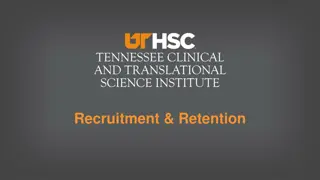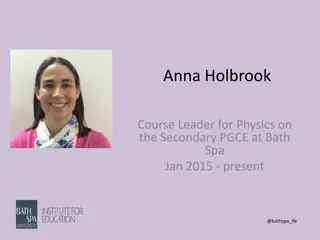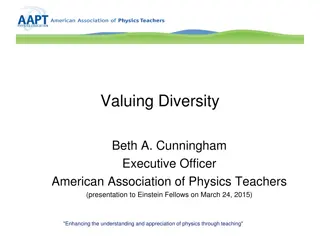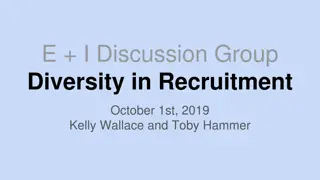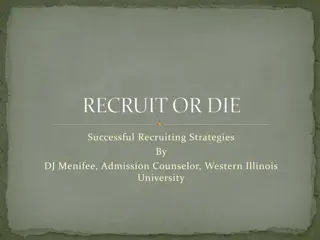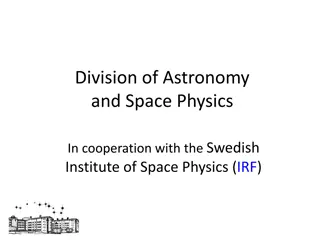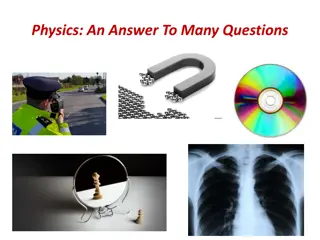Enhancing Teaching Recruitment Strategies for Physics Education
Marketing plays a crucial role in attracting potential teachers to the field of physics education. Initiatives include targeted digital campaigns and financial incentives such as tax-free bursaries aiming to recruit graduates in priority subjects like physics. By prioritizing physics-specific marketing activities and leveraging partnerships for promotion, efforts are made to boost recruitment in this essential subject area.
Download Presentation

Please find below an Image/Link to download the presentation.
The content on the website is provided AS IS for your information and personal use only. It may not be sold, licensed, or shared on other websites without obtaining consent from the author.If you encounter any issues during the download, it is possible that the publisher has removed the file from their server.
You are allowed to download the files provided on this website for personal or commercial use, subject to the condition that they are used lawfully. All files are the property of their respective owners.
The content on the website is provided AS IS for your information and personal use only. It may not be sold, licensed, or shared on other websites without obtaining consent from the author.
E N D
Presentation Transcript
Routes into teaching Provisional data on PG ITT new secondary entrants by subject and route 1,2,3,4,5,6 Table 1: Data sourced from the DfE Initial Teacher Training (ITT) Census, details the breakdown of secondary STEM trainees across the different training routes available. The table indicates the typical university route into ITT attracted the most STEM trainee teachers. Breakdown of STEM subjects between the different training routes (17/18 data) Higher Education Institution School Centred ITT School Direct (Fee) School Direct (Salaried) Teach First Subject 1205 320 575 170 145 Mathematics 505 110 225 75 85 Biology 365 105 165 55 20 Physics 430 110 250 40 25 Chemistry 220 45 95 10 0 Other7 120 40 90 40 5 Design & Technology8 255 55 135 15 5 Computing 3100 785 1535 405 285 Total https://www.gov.uk/government/statistics/initial-teacher-training-trainee-number-census-2017-to-2018
Marketing Marketing is the key strategic component for promoting teaching as a career and the benefits of training to become a teacher. . Why I chose to teach Get Into Teaching TV campaign Marketing approach Our Get Into Teaching communication prioritises the 7 priority subjects (physics, maths, chemistry, biology, computing, languages and geography) for all activity and accompanying assets. This is mainly done via: Watch out for a further burst of TV advertising throughout May to boost the national Get Into Teaching recruitment campaign. The 2 TV adverts are filmed in a working school, showcasing the pride teachers take in their job and why I chose to teach , and are being supported by advertising on social media online, in the press and on the radio. Key messaging focussed on the financial incentives (bursaries) on offer for priority subjects, and; Audience segmentation research and subsequent targeting basically planning our campaign around what channels/media index highly for the core subjects. Please follow us on Facebook, Twitter and Instagram; your retweets, likes and shares help to promote a positive image of teaching and are vital to our joint recruitment efforts. Our Direct Marketing team sends out subject-specific (physics included) emails to those who have registered an interest in teaching.
Physics specific marketing activity Physics Specific We run digital banners that are physics-focussed - aimed at potential physics applicants We run subject-specific ads across social media (including for physics). We have recently had a scholarship focussed Social Media Week where we sent out subject specific scholarship messaging. Our Partnerships team have produced several articles and case studies using current physics or science based teachers - https://www.theguardian.com/get-into-teaching/2018/mar/13/left-silicon-valley-teach-physics-there-no-comparison
Financial Incentives We have already implemented a number of financial initiatives that are designed to recruit more graduates into teaching priority subjects including the physics. Our bursaries are all offered tax-free. Bursaries - Incentives for AY 2018/19 include a generous bursary of 26,000 for trainees with a 2:2 or better in a relevant degree (sciences, MFL and computing). For maths, we are trialling a financial incentive package totalling a minimum of 30,000 is available and this is made up of: 20,000 bursary during their initial teacher training year, Two career bonus payments of at least 5,000 in their 3rd and 5th year of teaching, providing you have taught in a state-funded school in England since completing your ITT. There bonus payments are enhanced to 7,500 if teaching and specified areas of England Scholarships - We also offer prestigious scholarship bursaries to ITT trainees who are successful at securing a scholarship. Scholarships are aimed at the top C10% of ITT participants and offer enhanced training focused on quality and increasing the professional status of teaching. These are available for candidates with a 2:1 or above in chemistry, physics, maths, computing science, modern foreign languages and geography. For AY2018/19 science scholars (including computer science) will receive a 28,000 scholarship bursary. Maths scholars will receive a 22,000 bursary in their ITT year and are also eligible for the two early career bonus payments.
Package of Incentives to increase teacher supply 1/2 We have a number of initiatives that are designed to encourage more STEM and computer science specialists into teaching: Subject Knowledge Enhancement (SKE) programmes help recruitment to priority subjects in initial teacher training (ITT) by refreshing or building on an applicant s existing expertise, so that they are ready to teach their chosen subject. Funding is available for SKE courses in maths, physics, chemistry and biology; Paid Internships, which allow STEM undergraduates to experience teaching and to encourage them to commit to it as a career; Undergraduate with Qualified Teacher Status, where we have provided funding to support the best universities to develop new courses that provide pathways for maths, computer science, physics and MFL students to train to teach alongside their academic studies; and Maths and Physics Chairs, which recruits high calibre post-doctoral researchers who have a passion to teach maths and physics into the schools where they are most needed. We also have initiatives which support qualified teachers to teach STEM subjects: Teacher Subject Specialism Training (TSST) which offer school led-courses to upskill non-specialist with a strong STEM background in order to increase the number of STEM hours that can be taught. Returners - we also offer a range of support, including TSST, to qualified teachers who are not currently teaching but want to return to the profession.
Package of incentives to increase teacher supply 2/2 International Recruitment: Alongside this work to ensure we are recruiting the best and brightest STEM and computer science teachers from the domestic market, we are working with embassies and equivalent government departments in other countries to explore how we can boost domestic supply with STEM teachers from other countries. DfE is piloting a school-led approach for recruiting mathematics and physics teachers from abroad. We have awarded grants to two school-led networks to test approaches to attracting, recruiting, deploying, acclimatising and developing overseas qualified mathematics and physics teachers from native English speaking countries; USA, Canada, Australia and New Zealand. DfE are further expanding the pilot model via Teaching School Council to increase reach across the country and provide an additional supply route within the regions.
Retention Initiatives As well the Maths phased bursary (see slide 8) the government have a number of other initiatives to maximise retention rates. The Teachers Student Loan Reimbursement scheme is available to Biology, chemistry, physics, computer science and MFL teachers who have been awarded QTS status between A/Y 2013/14 2018/19 and are currently working in one of 25 participating local authorities*. The scheme is designed to retain and reward teachers by reimbursing student loan repayments that have been made in the previous year. We have also We are stripping away the workload that does not add value or give teachers the time and the space to focus on teaching. On 10 March 2018, we set out further steps we will take to do this. We announced that we will: enter a period of stability for assessment, qualifications and the curriculum; clarify the roles of actors within the accountability system; and launch a working group to look at data and evidence collection, and launched a video setting out what we and Ofsted do not expect schools to do. This follows on from our workload reduction action plan in February 2017, and we now working in partnership with the education profession to develop a toolkit to support workload reduction, and have run a series of regional events promoting practical approaches to removing unnecessary workload at school level. The DfE also delivers a number of subject specific CPD programmes to support teachers to teach the new curriculum and qualifications. Including on computing (a new 84m programme announced in Budget), maths (through maths hubs and the teaching for mastery programme), and science (through STEM learning and other programmes).








